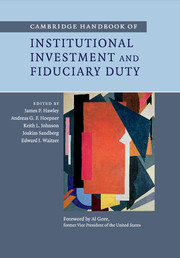Book contents
- Frontmatter
- Contents
- List of figures
- List of tables
- List of contributors
- Foreword
- 1 Introduction
- Part I Fiduciary duty: a global outlook
- 2 The public fiduciary: a Canadian perspective
- 3 The basis of fiduciary duty in investment in the United States
- 4 Governance and accountability in UK pension schemes
- 5 Institutional investment and fiduciary duty in Australia
- 6 The regulation of institutional investment in Sweden: a role model for the promotion of responsible investment?
- 7 The Dutch pension system
- Part II Fiduciary duty and the landscape of institutional investment
- Part III Challenging conventional wisdom on fiduciary duty
- Part IV Towards a broader interpretation of fiduciary duty
- Part V Beneficiaries’ roles and viewpoints
- Part VI Fiduciary duty and governance
- Index
- References
2 - The public fiduciary: a Canadian perspective
Published online by Cambridge University Press: 05 April 2014
- Frontmatter
- Contents
- List of figures
- List of tables
- List of contributors
- Foreword
- 1 Introduction
- Part I Fiduciary duty: a global outlook
- 2 The public fiduciary: a Canadian perspective
- 3 The basis of fiduciary duty in investment in the United States
- 4 Governance and accountability in UK pension schemes
- 5 Institutional investment and fiduciary duty in Australia
- 6 The regulation of institutional investment in Sweden: a role model for the promotion of responsible investment?
- 7 The Dutch pension system
- Part II Fiduciary duty and the landscape of institutional investment
- Part III Challenging conventional wisdom on fiduciary duty
- Part IV Towards a broader interpretation of fiduciary duty
- Part V Beneficiaries’ roles and viewpoints
- Part VI Fiduciary duty and governance
- Index
- References
Summary
Introduction
Fiduciary duty is a dynamic concept – one that has responded to changing contexts and worldviews but is firmly rooted in clear and enduring legal principles. As society faces governance challenges, there is a growing recognition of the need to take a longer-term and more systemic view of fiduciary obligations. This challenge is particularly acute in the financial services sector.
The Supreme Court of Canada (the “Court”) has focused on developing a coherent view of the nature of fiduciary relationships and the consequences thereof. In doing so, it has extended the scope for fiduciary duties and consequential remedies. After a summary discussion of how fiduciary duties have been applied in the pension fund context, this chapter reviews the efforts of the Court to develop this broader conceptual framework. We then consider, in the context of pension fund administration, steps that might be taken to address and mitigate liability in respect thereof. We conclude by considering the trajectory of the law – why pension fiduciaries are increasingly required to look beyond the immediate “imperatives” of the market to longer-term, systemic concerns, such as intergenerational equity and sustainable development. So positioning fiduciaries with public responsibilities will further alter legal and governance precepts.
- Type
- Chapter
- Information
- Publisher: Cambridge University PressPrint publication year: 2014

